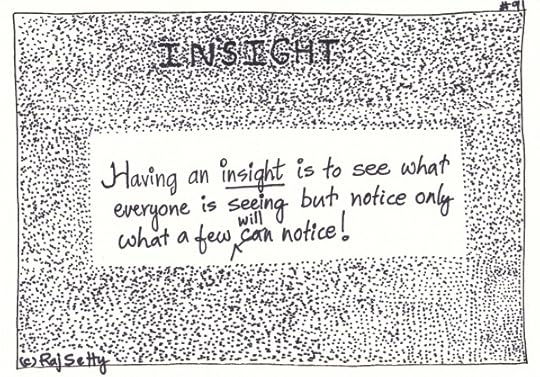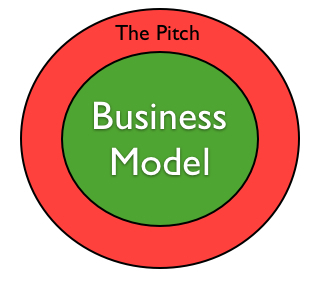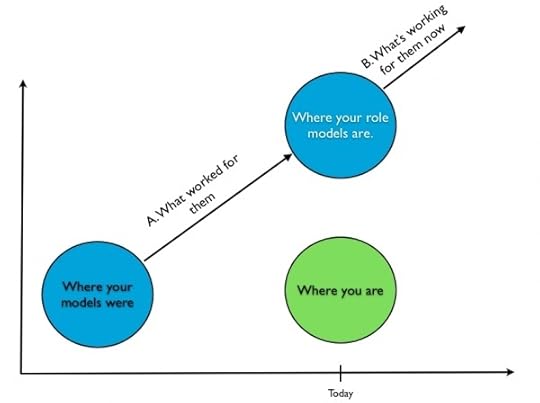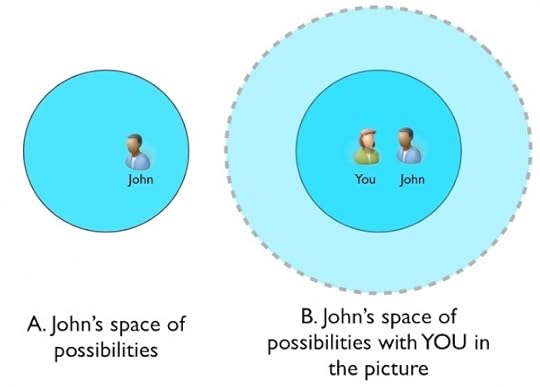Rajesh Setty's Blog, page 5
July 21, 2013
Three Examples of Practical Innovation
Having an insight is to see what everyone else is seeing but notice only what a few will notice. | Tweet This
[ Poster available at Sparktastic ]
Here are three examples of practical innovations where you will see “insight in action.”
1. Tesco: Homeplus Subway Virtual Store
This is where Tesco a supermarket in South Korea brings a shopping mall to train stations. People who are waiting for trains can shop and the items will be delivered when they get home. Win-win for sure.
Click here to view the embedded video.
2. S-Oil Parking Lot “Here” Balloons
Searching for an open parking slot can be a total waste of time (and waste of oil). Take a look at what S-Oil an oil company came up with to solve the problem with… balloons. Yes, Balloons!!!
Click here to view the embedded video.
3. Share My Dabba
Could you imagine just one simple sticker can feed hundreds and thousands of hungry kids in Mumbai. See the amazing Dabbawalas innovation story here:
Click here to view the embedded video.







July 20, 2013
Getting to the Start Line
You have heard about the enormous work that is involved in getting to the finish line of a meaningful project. An example – if you are writing a book, getting to the finish line is to see lives transformed by reading that book (it is not when the book goes to printing). Any meaningful project takes time, effort, energy and mindshare of unbelievable proportions to finally GET IT DONE.
I am not talking about that part of life. I want to go back to the basics – about getting to the start line of a meaningful project. It is very easy to get convinced that you are on the start line by engaging in activities in the grey zone – sometimes thankless, sometimes preparatory zone that might or might not get you to the start line.
Three Indicators:
To keep it simple, here are three indicators for a quick check to see if you are on the start line.
1. Demonstrated commitment
Demonstrated commitment in its simplest sense is when you have put something you deeply value at stake for the sake of this project or cause. A combination of your money AND reputation is one such example. If you have put your hard earned money and you put your name at stake for this cause, there is a good chance that you are heading towards the start line.
2. Continuous allocation of meaningful resources to the cause:
It’s not enough to demonstrate commitment, you also need to follow through. That happens only when you continue to allocate meaningful resources (time, energy, money, mindshare etc.) for the cause. How long is long? There is no easy answer for that. It depends on the project and standard “consulting” answer is however long it takes.
3. Measurable progress on the path to value creation
The above two indicators are inward looking. This one is external facing. Remember that you are embarking on a MEANINGFUL project – this means that at some point there is “value created” for a reasonable number of people in some way. There needs to be measurable progress on that path to value creation. This should pass the test by a third party with who is not in your circle of love – meaning you can’t ask your Mom or spouse to confirm that you are creating value along the way.
Over this weekend, wish you and your projects all the best!!
Note: We all have ideas for projects that can create massive impact. Bill Sherman and I hope to help some of you to make measurable progress in reasonable time via The Impact Habit. Stay tuned.







The Yearly Delta
This is a short and joyful video I watched tonight. It is one of those videos that you will watch without blinking. It’s a video of a cute little kid called Indigo. His Dad has captured a second of Indigo’s life everyday for the entire year.
Here is the video
Click here to view the embedded video.
It is a pure joy to watch the video.
You can see Indigo growing steadily every single day and by the end of the year, he is walking slowly to place a candle on a small cake.
Now, the point of this blog post apart from sharing the joyful video…
While you will most probably not be remembering your own first year of life, you would have seen several babies growing up around you. The yearly delta in the first year is simply stunning. If you are a parent (and if you are not, talk to any parents) you will see that yearly delta when a child is growing up is huge. There is physical growth and there is intellectual growth – there is growth everywhere.
Compare that yearly delta to the last few years of your life?
Are you happy about the rate of growth?
Since you are not going to share your answer with anyone, there is no reason to manufacture artificial delta.
If you think about it, your intellectual growth needs to be accretive – meaning the yearly delta should be significantly higher than your past year and yearly delta for your past year needs to be far higher to it’s previous year and so on.
Sadly, in most cases, the yearly delta is close to zero.
All you see is sideways movement at best.
Three Reasons for Sideways Movement
1. Accretive Capacity Building Does Not Happen by Chance
Once you are on your own, you have plenty of choices on what to do on a daily basis. For a long time, you can get away with mediocre performance or by just doing slightly more than what you are expected to do. The reality hits post 40 and it’s too late to do anything except finding good external excuses to blame for your situation.
A better approach would have built your capacity to perform and contribute in an accretive fashion allowing you to deliver more output with less input. If you are one of those who have got this equation working, congratulations. If you are not, it’s never too late to start thinking, designing and working on building accretive capacity. It rarely happens by chance. YOU have to be wanting to make this happen.
2. Good Help Becomes Optional
When you are growing up, good help was always available. There were a number of loved ones starting with your parents and siblings who would have proactively come to your help when you needed it most. If you were going off the road, they would again come to your rescue to bring you back on line. However, they had no intention to act as your crutch so slowly they allowed you to make your own choices and at some point you started making MOST of your choices yourself.
Good help was available but it was optional and on your call. You could get by without good help too. Sometimes you had to pay and get that good help that would have meant you had to redirect money from short-term entertainment items to long-term investment areas. That for some would have been a hard choice to make.
3. Good Karma Seems Like a Luxury
Good Karma in simple terms is to move the needle for someone else in a meaningful way.
Good Karma is not luxury – in fact, it should be the way of life. Relentless good karma is your surefire method to accumulate excess capacity that you may be able to draw on demand.
Unfortunately, you can’t fake good karma.
Either you are engaged in good karma or you are not. The former will give you multiple returns if done right and the latter is meaningless to start with.
The yearly delta is a meaningful measure of progress in your life and YOU can influence what it could be.
In this year, there are still five more months to make a significant difference to your yearly delta. All the best!
Here is a 17-point program to help you create the best year of your life.







July 18, 2013
7 Core Elements of Your First Startup
Your first startup is special for you and everyone else in your team. It is hard work in whatever way you look at it. I am not suggesting that this article will provide a full recipe for cooking up your first startup. That is not the intention. If after you read this, you will discover ONE or TWO things that you will pay attention to beyond whatever else you are doing, I have done my job.
So, without further ado, here are the 7 elements from my book:
1. Purpose
 It seems like the Purpose question by saying you’re going to make a dent in the universe, change the world in some way. However, nobody is going to believe you and your startup will be dead on arrival (especially if you are a first-time entrepreneur). However, you start with an aim of chaining the world for better for a reasonably large number of people in a particular niche.
It seems like the Purpose question by saying you’re going to make a dent in the universe, change the world in some way. However, nobody is going to believe you and your startup will be dead on arrival (especially if you are a first-time entrepreneur). However, you start with an aim of chaining the world for better for a reasonably large number of people in a particular niche.
For example, the following pitch will be a suspect:
We build productivity tools to save time for anyone using email.
A better pitch will be:
We build email tools to help busy salespeople become more responsive
Make your startup purpose believable to the external world and keep upgrading it internally | Tweet This
Ultimately, you should upgrade to the final version of your way to make it a truly world-changing cause.
The purpose in general answers the Why question. Simon Sinek who wrote the book “Start With Why” explains the power of Why brilliantly when he talks about Apple (today the world’s most valuable company) on their quest to always challenge the status quo and how they do it is by building awesome products. The key for Apple is the why – challenging the status quo. Insanely great products are a derivative of the Why.
Find Your Why as soon as possible as that’s the foundation for your startup | Tweet This
2. Product
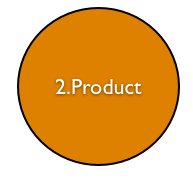 Since we covered the Why in the purpose section, we will now focus on the What in the product section.
Since we covered the Why in the purpose section, we will now focus on the What in the product section.
A product is a really good one that, once exposed, will be missed by the target market in their past.
Let me explain.
Let’s assume that you built an email productivity tool for salespeople. You showcase that product to a salesperson (one person out of your target market) and the moment the person experiences your product, he or she starts thinking how cool his or her life would have been if they had this product a few years ago – they start missing your product in their past.
A great product is one that’s missed by the target audience in their past | Tweet This
Nobody will miss your product in their past if it does not solve a REAL problem.
Most startups, unfortunately, have a solution that is waiting for a problem | Tweet This
But your startup doesn’t have to be facing that problem. As Phil Libin, says, your quest has to be sufficiently epic. Why spend precious years of your life on something less than that?
And, last but most important, know that:
A. It takes an insane amount of hard work to “stand out” when you have a good product.
And
B. It takes an insane amount of hard work AND luck to “stand out” when you have a lame product | Tweet This.
3. People
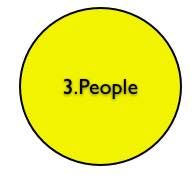 After why (purpose) and what (product), next comes the who – the actual doers of taking the what (product) to realize the why (purpose) over a period of time.
After why (purpose) and what (product), next comes the who – the actual doers of taking the what (product) to realize the why (purpose) over a period of time.
Without the right people on your side, your dream will remain a dream.
Apart from being competent people in the right domains (it’s people 101 right there), you and your team members have to be 10 out of 10 on the following:
3.1 Passion Factor:
How do you know the core founding team is passionate about what they are doing? Well, you know it because you will be doing what you are doing for the right reasons – especially you will be engaged in it NOT for money but because you truly believe that what you are doing will be world-changing.
3.2 Persuasion Factor:
This is more important than ever because to take your company to the next level, you will not want help but you will NEED help. There is no other way. Real significant help will come from really smart people and you will need to persuade those people to come and join your cause. Tricks won’t help here as who you are persuading ARE smart people and they will see through your tricks. So, what’s the other option? It is to build real long-term relationships with the ecosystem you are building long before you need to persuade them to come and join your cause.
3.3 Persistence Factor:
You don’t need a lot of persistence if the plans in your head happily get translated successful in reality. You and know that is rarely the case. Your plans are hatched in your head and you can never map the terrain and the reactions of the associated players in the real-life situation. So, plans need to be changed often and unless you have the right level of persistence, you will simply get frustrated and after repeated attempts, you will give up and move on.
4. Perfect Timing:
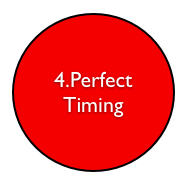 The best thinking about startup timing that I have heard is from my friend Phil Libin (founder and CEO of Evernote). It is as follows:
The best thinking about startup timing that I have heard is from my friend Phil Libin (founder and CEO of Evernote). It is as follows:
Startup Timing: Wait until the world changes so that an important problem goes from impossible to just really hard, then execute.
Phil talks about the timing for Evernote – smart phones on the rise, networks are ubiquitous, storage is cheap and more created a perfect opportunity to build Evernote.
It is easy to dismiss the timing argument with luck. You do that when others get their timing right – Yeah, they were at the right time at the right place. Sadly, that kind of attitude is detrimental in the long run because you shun the responsibility to design and craft a solution that leads to perfect timing.
Right now, assume that you can design for perfect timing. That will force you to think through what Phil brilliantly explains above:
* what was impossible before
* how has the world changed to make that something impossible to extremely hard
* how can you assemble a team of people to take advantage of THAT opportunity.
5. Partnerships
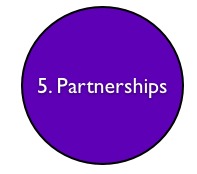 The right partnerships are amplifiers of your mutual capacity | Tweet This
The right partnerships are amplifiers of your mutual capacity | Tweet This
Your partnerships can extend your influence and/or enhance your ability to fulfill your promise and/or stretch the rewards and/or shorten the time to your goals and more.
No startup is an island and no startup can succeed as an island. it requires a super solid ecosystem to become super solid as a company.
Partnerships are harder to build than you can imagine. Why? Because the “good” partners are always busy because a LOT of companies are reaching out to them so that they can benefit from their ‘goodness.” On the other hand “not-so-good” partners are ready and willing to listen to you but succeeding in building a partnership with them is useless (and actually can be an opportunity cost) as finally it will lead to a “not-so-good” outcome.
Long story short – no partnership can give you a free pass, especially in the early stages as it requires a BIG investment from both sides to make this WORK. But it’s all worth it because the outcomes will be good for both parties.
6. Profitability
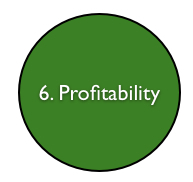 Profit in its simplest sense is revenues minus costs. So, if you are generating more revenues than it costs to deliver the promises associated with these revenues, you are already doing good.
Profit in its simplest sense is revenues minus costs. So, if you are generating more revenues than it costs to deliver the promises associated with these revenues, you are already doing good.
However, it’s not that simple in the real world because you keep getting conflicting advice throughout the journey about your priorities. One person might tell you that you should not worry about revenues and profits until you get adoption and critical mass while another person might tell you that you should never lose sight of revenues and profits.
What should you do?
Well, it depends on what kind of a company you are building and what resources you have to get there
If you are building a company that requires a massive user base and later you can monetize them, you need to start thinking about a PATH to profitability all the time. You also need backers (mainly investors) who believe that your team will be able to pull this off in the long run and willing to bet on that journey by funding you.
If you are not building the above kind of company, you better know how to reach profitability NOW.
7. Preparation
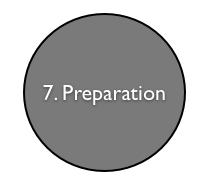 Startups always look simple from outside. First startups are insanely hard if you are not prepared for the journey that is involved.
Startups always look simple from outside. First startups are insanely hard if you are not prepared for the journey that is involved.
It seems like there is a dilemma here.
How can you get experience in a startup until you are in one of them?
It seems like an impossible requirement.
Actually, it’s not. You don’t have to wait for your own startup to gain experience in a startup. If you are wantrepreneur, right now there are at least a dozen startups around you who are looking for a helping hand. They may not be able to “pay” you but for sure they will trade “experience” for your “contributions.”
Really, there are enough opportunities everywhere for you to get your hands dirty. Here is a bonus – If you are helping any other startups in your own quest to build your own skills, you will win twice – once via building your skills in a not-so-sandbox environment and twice by accumulating good karma. Both will go a long way in your quest to build a world-changing startup.







July 16, 2013
7 Steps to Getting Your Startup Story Right
Reading about startups and trying to build one is like reading a book and jumping into the battleground to fight. Life in a startup is very different for those that are living in one of them and how it appears to someone from outside. That does not mean that there is no point in reading about startups. This is how you expand your “background knowledge” on the topic so when a situation arises in your life, you have something in the background to get a head start. Nothing can replace the power of actual experience but being prepared and equipped will take that experience to a whole new level.
A good startup story is a brilliant choreography involving the right players in the ecosystem | Tweet This
Disclaimer: This is the framework we use at Foresight Plus to craft startup stories. It takes months or months to get everything right. This article is a condensed (and generalized) version of that thinking to help you get started.
Here are 7 steps to getting your startup story right:
1. Identify
 It starts with identifying a “real” problem or an opportunity. Ideally, you should find a missing piece of the puzzle that will complete something important for your target audience. If the problem is simply manufactured in your head, the solution does not have to be built in real life. If there is a problem in real life, the pain of going through that problem has to be quantifiable else the switching costs will be super high.
It starts with identifying a “real” problem or an opportunity. Ideally, you should find a missing piece of the puzzle that will complete something important for your target audience. If the problem is simply manufactured in your head, the solution does not have to be built in real life. If there is a problem in real life, the pain of going through that problem has to be quantifiable else the switching costs will be super high.
In the Identify phase, you have to be able to identify one or more personas of buyers that will be your target buyers. Your job is to get into their shoes and experience a day in their life without and with your product or service.
If you don’t know who the ideal buyers are, chances are that they don’t know who you are | Tweet This
2. Verify
 How do you know that the problem is real if you have never talked to the target customer? This is the phase to get out of the ivory tower and start talking to as many people as possible. Although Steve Blank and Eric Reis have made customer development and lean startup methodology household names in the startup ecosystem, there is still a lot of reluctance from entrepreneurs to actively start talking to target customers early in the Lifecycle of a company.
How do you know that the problem is real if you have never talked to the target customer? This is the phase to get out of the ivory tower and start talking to as many people as possible. Although Steve Blank and Eric Reis have made customer development and lean startup methodology household names in the startup ecosystem, there is still a lot of reluctance from entrepreneurs to actively start talking to target customers early in the Lifecycle of a company.
Some entrepreneurs quip back citing examples from Alexander Graham Bell to Steve Jobs who could not or did not do market research respectively but went ahead with amazing innovations. What they conveniently forget is that companies kind of Apple comes once in a century and there is no point in chasing or mimicking exceptions of that kind.
When you are in the verify phase, the big things you are validating are:
a. The problem you are solving is real
b. The problem you are solving is big enough that either something is being done about it or they will be open to doing something about it.
c. The problem is urgent enough that something needs to be done now.
d. Your solution to that problem is priced such that cost of suffering is much much higher than cost of implementing your solution.
You can rarely build your right startup with wrong assumptions . Verify now and often. | Tweet This.
3. Clarify
 The next step is to bring more clarity to the “why” you are embarking on a journey so that the target buyer sees the value almost immediately. When your value proposition is clear, stating that in front of your buyer will produce an “aha moment” for them. The best response you can get from your story is “Hmm.. How come somebody was not already doing this..”
The next step is to bring more clarity to the “why” you are embarking on a journey so that the target buyer sees the value almost immediately. When your value proposition is clear, stating that in front of your buyer will produce an “aha moment” for them. The best response you can get from your story is “Hmm.. How come somebody was not already doing this..”
A very well told sales story will appear like you are stating the obvious in a compelling way | Tweet This
This is where the need for learning the fundamentals of storytelling becomes key. Since your target customer will ALWAYS be a human being and since human beings respond to stories, it is in your best interest to invest in that education.
If your story is on the money, the buyer will be willing to part with his or money | Tweet This
Related Reading: How to weave a story around your startup?
4. Simplify
 At the outset, if you have gained clarity, there should not be a need to simplify further. But the way I look at it, simplify phase will take it to a level where even people who are outside the “inner circle” will be able to appreciate the value you are bringing to the table. This means that people who are interested parties but non-buyers would be fascinated by your story.
At the outset, if you have gained clarity, there should not be a need to simplify further. But the way I look at it, simplify phase will take it to a level where even people who are outside the “inner circle” will be able to appreciate the value you are bringing to the table. This means that people who are interested parties but non-buyers would be fascinated by your story.
Why would you need this step?
Is it not sufficient for target buyers to get excited about the story?
An enduring company needs a solid ecosystem to survive and thrive. Take for example the investor group that you are courting. They are not the target buyers but they will be very interested to know that the target buyers are very interested in the solution you are bringing to the marketplace. You need a super simple way of explaining your value proposition to win their hearts and minds.
5. Solidify
 To solidify is to strengthen your ecosystem that will help you fulfill the promise that you are making to the world with your (ad)venture. This is where you build your team, your extended team, your advisory board, your board, designers, developers, your partner network and your influence network and more. Whatever you can do to strengthen “who you are” has to be always in the back of your mind but this is the time to execute on it.
To solidify is to strengthen your ecosystem that will help you fulfill the promise that you are making to the world with your (ad)venture. This is where you build your team, your extended team, your advisory board, your board, designers, developers, your partner network and your influence network and more. Whatever you can do to strengthen “who you are” has to be always in the back of your mind but this is the time to execute on it.
You should have completed the Identify, Verify, Clarify and Simplify phases so that when you are recruiting the support of key people, they see a story compelling enough to lend their name and mindshare for the next phase and beyond.
Solidify is a phase where things will start to be in the “work in progress forever” mode. Why? Because the ecosystem has to match the market needs and the phase of the company and both keep changing along the way.
6. Amplify
 Amplify means to extend the reach of your offering. Without solidifying well, amplifying might create a disaster as you haven’t prepared to scale. If you have followed all the steps so far, you already have the elements ready to amplify.
Amplify means to extend the reach of your offering. Without solidifying well, amplifying might create a disaster as you haven’t prepared to scale. If you have followed all the steps so far, you already have the elements ready to amplify.
You, your team and your extended team can choreograph a series of events that will raise the awareness of your offering, build a bond with your target audience, stand out from the competition and ultimately became the “default” choice when the need related to your offering arises in their mind.
How do you do this?
You start by demonstrating your thought leadership, caring for the target audience and moving on to break away from the way you care for your target audience and ultimately by working towards a series of accomplishments that will provide instant social proof and credibility to help boost the trust factor about you and your offering.
7. Gamify
 Gamify seems like the latest buzzword but all we are trying to do here is that you build things into your offering that will help the users form new habits that include your offering in the mix.
Gamify seems like the latest buzzword but all we are trying to do here is that you build things into your offering that will help the users form new habits that include your offering in the mix.
Remember that the world existed happily without your offering in place and probably the world will continue to exist without your offering. For you to make a dent in the universe, the idea and the belief that your product is a “must” have to spread without friction. In essence, your offering should become part of their life (where it makes sense, of course). Gamifying will accelerate the process of adoption and frictionless transfer of your beliefs about the offering.
All the best!







July 15, 2013
All You Have to Do is to be You…or Not
It is true that not everyone is comfortable with being themselves. It is also true that there is no need to be guilty of just who you are.
Social media is filled with sayings that will talk about the need to be Yourself in the name of authenticity. Some of these sayings are very cute too.
One such saying from Oscar Wilde goes like this -
Be yourself because everyone else is taken.
At the outset, it is an insightful saying. Really, there is nothing wrong with it. It is witty to the core but it is the truth. It’s hard to argue against it because honestly, how can any person be someone other than who they are???
The Deadly Combination
Over the years, I have seen this kind of advice being used to trigger the deadly combination of convenience and complacency. You can explain away literally any outcome in your life by stating – “that’s just me, that’s the way I am.” You can by a klutz or late for meetings or just plain irresponsible but you can explain all that away by saying, “that’s just me…”
However insightful any saying is, people are smart enough to use it for their convenience and many times using it as a crutch to trigger complacency.
If “being yourself” is a convenient trigger to your complacency, you are in trouble | Tweet this
Nobody, except you can decide to do anything different from what you are already doing – it is always a choice. However, by stubbornly wanting to be “just yourself” because everyone everybody else is taken is not the way to go because there is one person that’s not taken yet.
The One That’s Not Taken
The one person that’s not taken yet is a Better You. It is not a luxury anymore to work towards a better you but it’s something of a requirement. It might not have been a “requirement” three decades ago as the rate of external change was small compared to what it is today. Today, you need to be running to just to stay where you are. You can never catch up with someone “who is growing everyday” by “just being who are you are today” The delta between you and one of your peers who is investing in themselves will be super small on a day-to-day basis but over a span of ten years that delta will grow to the size of Grand Canyon at the least. If you wake up at that time, it will be too late to do anything.
What can you do starting now?
So, we agree that “A Better You” is someone that’s not taken yet and it’s a good path to be on. What can you do today to start on that path?
The list of how you can be a better you will fill many volumes of self-help books as you can imagine.
Let’s start with three things:
1. Watch what you consume:
You are all familiar with the old geek term – GIGO (garbage-in, garbage-out) but it’s super easy to forget as you may literally have no time to reflect on what you are consuming. My theory is that you should be open to everything but extremely careful where you will continue to invest your mind share. Why? Because it is not good to shut off without knowing what you are shutting off. But it is not worth continuing to engage with anything unless that will lead to being a better YOU in the long-term.
2. Watch what projects you are engaged with:
The biggest chunk of your mind share gets invested in the projects that you are engaged in. If the projects are too easy, then the warning bells should ring right away. Any project that’s mundane will never help you grow. Easy pickings today is a recipe for tomorrow’s disaster. The path of least growth is a shortcut
David Burwen, fellow member of the Band of Angels stated it brilliantly when he was sharing with us a single line strategy for all professionals - “When deciding among opportunities, always choose the most difficult path.” (A Buddhist Quote)
Your current projects are your playgrounds where you build future capacity. Choose them wisely | Tweet This
3. Watch what conversations you are engaged with:
Every conversation counts in ways that you cannot even imagine. A casual conversation in an airplane with your next seat mate may have the power to change the trajectory of the rest of your life. If you bring all you have got into everyone of your conversation AND if you choose to make it a habit to create an impact, the world will notice it sooner than later. It takes some practice but learning to be instantly immersed completely in the current context will yield amazing results.
Until you reach a level where your unconscious competence is awesome, it is best for you to craft your conversations to move the needle. It starts with your intent – you should WANT to make your conversations matter. Do it for your own reasons as that intent will drive and stretch your imagination to contribute and in the process, your own growth is guaranteed.
Your output (life journey) can never be independent of your inputs (choices and actions) | Tweet This







July 14, 2013
Romancing the Pitch…
 The easiest advice you can give to a first-time entrepreneur is to ask him or her to make their pitch better.
The easiest advice you can give to a first-time entrepreneur is to ask him or her to make their pitch better.
Why?
Two reasons to start with:
1. That advice (unintentionally) implies that everything else about the business is quite all right and all it requires is a pitch upgrade.
2. If you are that entrepreneur, you might take that quite literally and start working on the components of the pitch (narrative, length, structure, sequencing etc.) and/or the mechanics of its delivery (tone, style etc.)
Combine reasons #1 and #2 and you have a disaster in the making.
As an entrepreneur, you might start believing in your own (flawed) story and start searching for someone who can “just” fix the pitch and you will be off to the races.
Upgrade your pitch ONLY after you upgrade your story. Tweet This
Recently, an entrepreneur wanted help with his pitch upgrade and it was not hard to see that it was not the pitch that was the problem but the assumptions he was making about the business was wrong. The way the business was structured, it would fail the moment it started getting traction. I spent some time explaining why the business idea was flawed and how to fix it. The entrepreneur nodded in agreement. A day later, I got an email with the old pitch with a request to make a few minor changes so that he can get through an upcoming review.
A bad business model cannot be salvaged with a great story. Tweet This
In fact, a solid business model and a great story will at best have 10% chance of succeeding so anything that’s less than a 9 out of 10 on the business model is destined for failure very shortly.
Your pitch is important but it’s not everything
Your pitch is super important. It’s like the cover of the book. Without a good pitch, doors are shut for you. But, that does not mean that you will get a carte Blanche for moving ahead. It’s a start and at best a door opener. Without getting the underlying elements strong, your attempt to get a strong pitch will be futile.
The genesis of the real problem
As an entrepreneur, it really starts with you. If you ask someone to just help you with the pitch, you might just get that – an upgrade on the structure of the pitch or an upgrade on the mechanics of it’s delivery. The underlying problems may not go away.
So, stop asking people to help you with your pitch until you are totally convinced about the strength of all the underlying elements.
Where can you start?
I always advise that you *start* with three key elements in the business model. I am emphasizing start here mainly because there are a lot more elements that you need to get right to get your business a head start.
Here they are:
1. Source of Revenues:
Somewhere in your business model, there will be someone who will need to pay you for something (a product or a service) – so you start with your potential target customer. The general flaw in this department is the assumption that when your product or service is ready, the target customer is open and willing to engage with you to transact and acquire the product or service.
Any target customer (you included) will have an unbelievable amount of resistance to change even when he or she knows that the change is good for them.
The benefits (A) of changing from where they are to the new state has to be super significant as compared to the “perceived pain” (B) you think they are experiencing in the current state.
Because you want to believe in your service so badly, you might miss a few things such as:
a) What percentage of your target customers acknowledge that they are experiencing any level of pain in their current situations. Remember that people get used to some level of pain and assume that it’s part of their life.
b) What percentage of your target customers are open and willing to consider a change if a viable solution comes their way
c) What percentage of target customers will actually follow through on their promises and make the switch to include your product or service as the solution.
d) What percentage of target customers who made the switch actually continue to use your product or service for a foreseeable future.
The answers you get for the above may not be pretty but ignoring those answers won’t make the questions go away magically.
2. Cost of Delivery:
If you give something really amazing at a throwaway price, you might find a boatload of people standing in the queue to buy that amazing thing. However, you might go bankrupt fulfilling the requests as you will have costs of delivery. When you are green, it is very easy to underestimate the costs of delivery because in your mind things will happen flawlessly because YOU are in control of the delivery.
A few things that are easy to miss:
* It ALWAYS takes more time and more money than your wildest estimate to deliver something awesome. So once you have estimated everything, you can safely double that number so you are not surprised.
* Murphy’s law (if anything can go wrong, it will) will spring up as an unwelcome guest every now and then. You need to factor that in.
* Needs change and new players will come into the market. You will need to change your best laid plans (fancy term – “pivot”) based on the new findings along the way. You need to factor in the “change costs” that is involved in the pivots
* When you pivot, you may realize that there needs to be a change in the team composition as the earlier team members may not actuarially be the right fit for the new direction. Any change in personnel comes at an “emotional” cost and there is no simple way to factor that in.
3. Mode of Distribution:
This seems simple but we all know that it is not. How do you take something you have created to the right target market.
A few things that are easy to miss:
* The cost of acquiring a customer (CAC) is always higher than what you estimate. This is because, for you the solution makes perfect sense.
* It is easy to overestimate the power of your personal network to bring the deals to the table. While you are important to everyone in your network, they also have a lot of other people in their network to pay attention to. So, talking to everyone in your network may be easy but transacting with your network takes time, effort and energy.
* Any meaningful distribution network that has access to a large enough audience will be approached by many companies to get their products pitched through that network. The result is that you need to “win” the mindshare of these networks to give you the attention. This means you should have spent a LOT of time beforehand to build and nurture relationships with key distribution networks. For your first company, “build it and they will come” is something that is more of a dream.
Your story should at least incorporate the elements that will remove the doubts in the three key areas above. Your pitch should be succinct enough to create enough curiosity to want to know your story.
PS: One more thing: It is a common flaw to focus on building an ecosystem that will consume when your energy has to be spent on building ecosystems that will contribute. Let me explain. In any ecosystem, there will be players that will consume (companies to whom you will pay) and there will be players that will contribute (companies who will pay you). The temptation is to start talking to a lot of people to whom you will pay because it’s just an easier conversation. Most of them will support you completely because in case you succeed, they will win. If you get into this trap, you will lose twice – once because you lost a lot of time that you could have used to build the ecosystem that will contribute and twice because now in your mind there is a higher sense of progress.
So, finally,
Focus on building an ecosystem that will contribute before you focus on building an ecosystem that will consume.







July 3, 2013
The Role Model Blind Spot
A role model is someone who sets an example of where you want to go and who you want to become.
A coach is someone who will help you to get from where you are to where you want to go.
Putting the above two together, if you have a good coach, he or she might help you to create strategies to design your life similar to that of your role model. But unfortunately, not many people have coaches. But why fear? Unlike a decade ago, today you can just Google and find out what your role model says their success secrets are and probably all you have to do is to follow them and you will be there.
This is precisely where you will hit upon a blind spot. Let me explain.
When your role model shares his or her strategies, tactics, preferences and their world views, remember that one or more of them might be true resulting in the blind spot:
* He or she might share working for them now not what worked for them when they were at your stage.
* Their current focus is to find strategies and tactics that will take them from where they are to where they want to go. They might even forget what strategies and tactics brought them to where they are today.
* When they share about their journey to where they are, there is a really good chance that their stories may be “enhanced and updated” for their convenience.
* Even if everything what they are saying is true, the ecosystem in which they are operating has been completely upgraded because of who they have become. Strategies and tactics are always to be looked in the context of an ecosystem as they can’t operate in a vacuum.
Here are a couple of examples of blind spots:
Imagine an entrepreneur who has been so inspired by Zen that he has taken a minimalism route for the next phase of his life. The entrepreneur might get a ton of press because what he or she is doing is not ordinary. [ Note for you: That entrepreneur may have had multiple exits before and you may be on your first company. Plus, you won't get any press if you follow him as you have no such accomplishments in your past ]
Imagine an author who prescribes that there is no reason to do anything on the web for the sake of traffic. [ Note for you: The author might already be getting so much traffic already that in his case he might not need to do anything specific to get more traffic. The current traffic will beget new traffic. In your case, you may just be starting off and this would mean that you HAVE to do something to get traffic. I am not suggesting that you do silly things to get traffic but you have to walk the extra mile for sure]
If you miss this blind spot and blindly follow the advice, note that you are bound to get frustrated because the strategies and tactics are displaced in time. You have to do one of the three following things:
1. Record those strategies and tactics somewhere so that you can revisit them when you reach a point in your life where they become practical for you to implement.
OR
2. Go back to the history of your role models. Go back at least a few years back so that there is a reasonable match to your current state and their historical state and observe how they built their life from there. Get the wisdom from that time, translate them to make those strategies to work for the current times and go all out.
OR
3. Get a great coach who will guide you through all the above translation and focus on being the best you can be NOW.
In summary, what works for your role models today may not be what works for you to get to where they are today.
All the best!







July 2, 2013
7 Steps to be a Game Changer in the Lives of People
First, a quick definition of game changer. According to the dictionary, it is
A newly introduced element or factor that changes an existing situation or activity in a significant way.
So if you want to be a game changer in the lives of others, you have to be that “element” that will change their life situation in a significant way.
To keep things simple, let us assume that significant way is something positive and one way to do that is by expanding the space of possibilities for that person in consideration.
Here is a model to consider:
1. Yearn:
It starts with a yearning to make a difference in someone’s life. You can’t fake this as and the difference between being genuinely yearning to make a difference and pretending-to-want-to-make-a-difference is like the difference between black and white.
If your heart is not here, skip the rest of the article as it will be a waste of your time.
2. Learn:
The next step is to learn what matters most to the person. There is a simple trick to learn what matters most. It is to listen way more than you talk. If you listen to anyone sooner than later he or she will talk about what matters most. However, if you talk more than you listen, you will scare them away from your network sooner than later.
[ Related: Download the book Lasting Relationships for free ]
3. Earn:
You need to earn the trust of the person in consideration that you have valuable help to offer. How do you do it?
* You start by accumulating relevant accomplishments in public and build a personal brand that matters.
* You continue by privately caring for what matters most to them. The combination of public accomplishments and private caring is generally powerful and brings credibility + specificity to the task at hand.
* You walk the extra mile by providing value without expecting anything in return. This is also important to eliminate the free riders as there will be a vast majority of them.
Without trust, you need to sell twice. Once you have to sell yourself and next you have to sell whatever else you are selling (in that sequence)
4. Adorn:
Adorn is to make something more attractive. In this case, you bring everything you have got to bear to enrich the life of the person in consideration. To set the stage to make this happen, you should have completed the first three steps – you need the yearning to make a difference, you need to have learned what matters most and you should have earned the trust of the other person that you have “significant help” to provide to them.
There are many ways to move forward with this step but really at the heart of it, there is only one step:
It is to use your intelligently configure and leverage your available assets to move the needle in a meaningful way for the person in consideration.
Your assets can be your network, your unique knowledge that will help with the current situation, your personal brand to amplify their causes, your ideas and insights to provide them an advantage and so on. It need not be very complex – it could start off with an article or a video that can make a difference now and in the future.
This requires deep thinking because of the two keywords above – configure and leverage. For instance, if you want to connect “someone in your network to this person,” your first job is to THINK and see how can you make this a win-win situation for both parties. It won’t happen magically unless you are making a conscious effort to make it relevant to both parties NOW.
The magic is in your ability to find the right puzzle piece to solve a puzzle in their life.
5. Turn:
Nothing in life is static, not your life and not their life. It changes all the time and what matters most to them today. When you truly care, you will turn to the “new” what matters most so you are tracking them to help them along the way. In fact, if you play your part well, you will be right beside them as they turn new chapters in their life. You will be part of their extended family.
6. Upturn:
If you are passionately engaged in all the above steps, there is no other outcome possible except a measurable upturn in the life of the person in consideration. It is not a notional upturn but something that can be seen and measured. It is the only way you get real feedback on whether what you are doing is working or not.
How do you know whether there was a measurable upturn? For one, they will see an increase in capacity to get things done that matter most to them.
7. Burn:
This is where you burn the midnight oil to keep ensuring that you are a better YOU as compared to yesterday. If you are not growing, you can’t be helping others to grow. Even if you are doing very well today, you will slide down without continuous investment in yourself.
Honestly, if you want to be a game changer in the lives of people, it will have to start with changing the game of your own life for the better.
Two parting thoughts:
1. If you are not acting as a game changer in the lives of those you care, it is not too late to start.
2. If you are not thanking those game changers in your life, it is not too late for that either.







Richie Norton on The Power of Starting Something Stupid
 It was great way to start the second half of 2013 with a phone conversation with Richie Norton, the author of The Power of Starting Something Stupid. This is Richie’s second book (after Resumes are Dead and What to Do About It). Richie shared with me that the book was the result of his quest to find out what makes some people successful.The answer surprisingly was that there was a pattern that was common for most successful people – they all started something stupid (or at least what people around them thought was stupid).
It was great way to start the second half of 2013 with a phone conversation with Richie Norton, the author of The Power of Starting Something Stupid. This is Richie’s second book (after Resumes are Dead and What to Do About It). Richie shared with me that the book was the result of his quest to find out what makes some people successful.The answer surprisingly was that there was a pattern that was common for most successful people – they all started something stupid (or at least what people around them thought was stupid).
Here is a quick interview with Richie on topics surrounding the book:
RS: What was the inspiration to start the book?
RN: If I can sum up, I would say there were three main things:
1. Over the last six years, I have been on a quest to find out what makes people successful. I discovered that more often than not, it is their courage to start something so called “stupid” or “crazy.”
2. I lost my 21-year-old brother-in-law and my 10-week old son (both named Gavin) and it hit upon me that life is too short not to act on those most pressing thoughts that come to our mind even if they seem “stupid.”
3. I was doing retirement consulting and learned that many people in retirement had waited their whole lives to do something they wanted to do. They waited for more time, more education or more money, only to find out when the time they imagined they could start their dream came, they still needed more time, more education or more money. Further, they had to navigate a completely different set of circumstances than when they originally had their dream–a spouse had passed away, their health had changed or they didn’t have the money they thought they would have. I learned that waiting to start dreaming until the “smart time” comes can be dangerous and that now (the present moment) is the only time we are truly guaranteed.
[ Related: Please read why some smart people don't take action? ]
The above three together inspired me to write the book.
RS: Did you start anything stupid personally, Richie?
RN: Yes. I’ve a very stupid person. I’ve started many stupid things, actually (smile)! But let me start with something early in my life. I went to BYU (Brigham Young University) at Hawaii. We had students from 70 different countries – so a very diverse crowd. Many students wanted to go back home, but had a hard time seeing opportunities for employment.
I was student body president at the time and started thinking about the challenge these students faced. I asked myself, “What could they do? and “How can I help?” and after a while I had an epiphany so to speak.
What if they could find self-reliance through self-employement in their home countries? Entrepreneurship seemed to be the answer. I wrote a business plan on this topic and showcased it in the business plan competition. Sadly, the plan failed at the first stage.
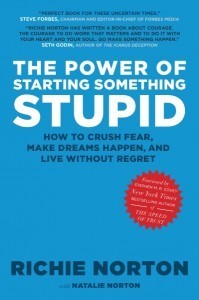 Some people may have given up when they were told their plan was a failure, but I didn’t stop there. Some said I was “stupid” or “crazy” for going after this dream to help people start businesses in developing countries, but I persisted. I actually raised money, created a fund and decided to back certain budding entrepreneurs who had won the business plan competition. For example, a woman from Mongolia wanted to start a cashmere company and had won the competition a couple years earlier. So, I went ahead and backed her and became a part of the cashmere company. It was a reasonable success and “stupid suddenly became smart.” BYU-Hawaii worked closely with me to help create the business model and put mentors in place. They then used that model to legitimize the need for a Center for Entrepreneurship (which has now been established) and since then many students have been helped to start companies in their home countries
Some people may have given up when they were told their plan was a failure, but I didn’t stop there. Some said I was “stupid” or “crazy” for going after this dream to help people start businesses in developing countries, but I persisted. I actually raised money, created a fund and decided to back certain budding entrepreneurs who had won the business plan competition. For example, a woman from Mongolia wanted to start a cashmere company and had won the competition a couple years earlier. So, I went ahead and backed her and became a part of the cashmere company. It was a reasonable success and “stupid suddenly became smart.” BYU-Hawaii worked closely with me to help create the business model and put mentors in place. They then used that model to legitimize the need for a Center for Entrepreneurship (which has now been established) and since then many students have been helped to start companies in their home countries
RS: I am sure people have a lot of stupid ideas. Which stupid ideas should they choose?
RN: I get asked this a lot. My response always has been to follow what I call the “Will I regret it when I am 80 rule.” I learned this from Jeff Bezos’ example. Let me explain.
When Jeff Bezos hatched the idea for Amazon, he was working on Wall Street and was making good money. When he explained his idea to sell books online to his boss, his boss told him that it “would be a better idea for somebody who didn’t already have a good job.”
Jeff thought about it for a while and it was clear that if he didn’t give this a shot, he would regret it when he was eighty. He quit the job in the middle of the year (crazy because he would lose the annual bonus) and started Amazon. The rest is history as we know it. [You can read more about this incident here: http://www.achievement.org/autodoc/page/bez0int-3]
People have to think – “Of all the ideas they have, which idea would they regret most not doing?” and then go ahead and execute on it.
RS: Where should someone start?
RN: People are good at having a really big vision. They picture changing the world. But, they seem to wait until they have more time, education, money and connections. I urge them to step back and focus on just getting ONE going. Start with what’s right in front of them. They should strip away all the stuff and start with that one individual.
I use the acronym S.T.A.R.T to explain the process
S | Serve – Serving other people helps you start relationships.
T | Thank – When you are grateful and thank other people, you solidify your relationships with them.
A | Ask – An appropriate way to ask is to do what I call “mission matching.” You ask them something that they wanted to do anyway. You match your ask with their mission.
R | Receive – You have to be open to receiving. You can accept the gift and stop there or you can be open to receiving it AND doing something about it.
T | Trust – You then have to start trusting the process.
RS: Are there some quick takeaways from the book that you can share?
RN: I’d be happy to – here are five of them:
1. Gavin’s Law. As I explained earlier, my brother-in-law Gavin and my son Gavin passed away early in their lives. Life is short and there is no need to postpone your dreams. Gavin’s law is – “Live to start and start to live.” In other words, if you live to start your so called “stupid” idea, you will start living the life you dream.
2. Destroy the waiting place: Life is too short not to start something stupid.
3. Do whatever it takes: Lean into stupid and don’t run away from it. Unsuccessful people run away from stupid because they are afraid of being shamed.
4. Clear the clutter, make room for the dream.
5. To overcome what I call the “Terrible Three”: Fear, Pride and Procrastination. You can then become authentic and be yourself – that will start your upward journey.
Have a great week ahead.







Rajesh Setty's Blog
- Rajesh Setty's profile
- 6 followers


